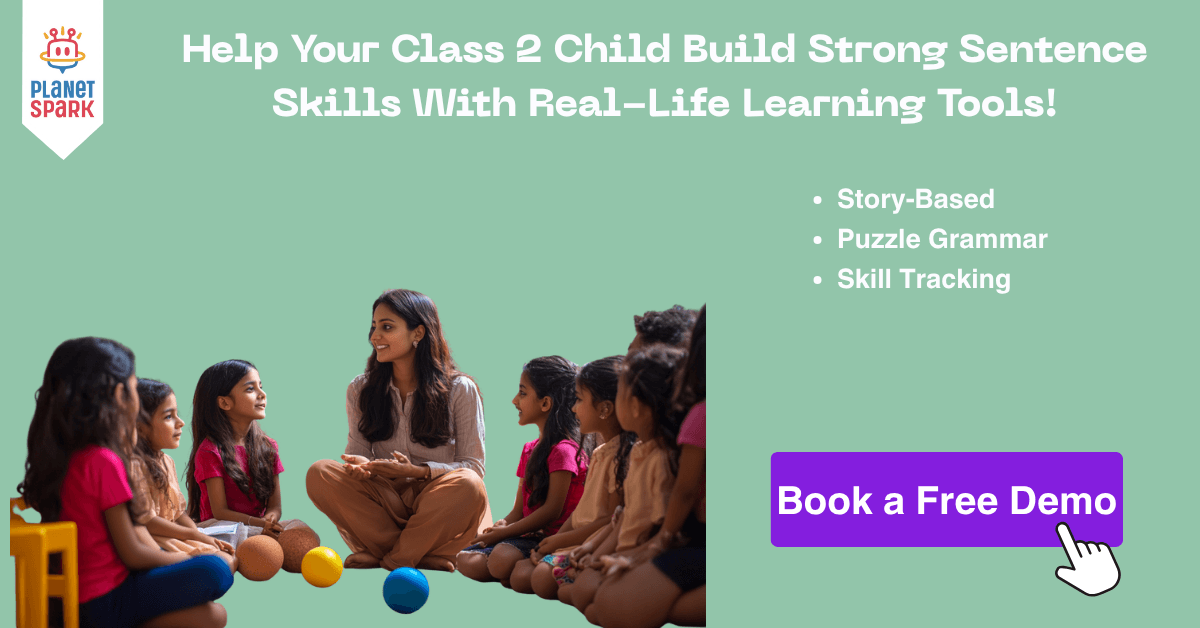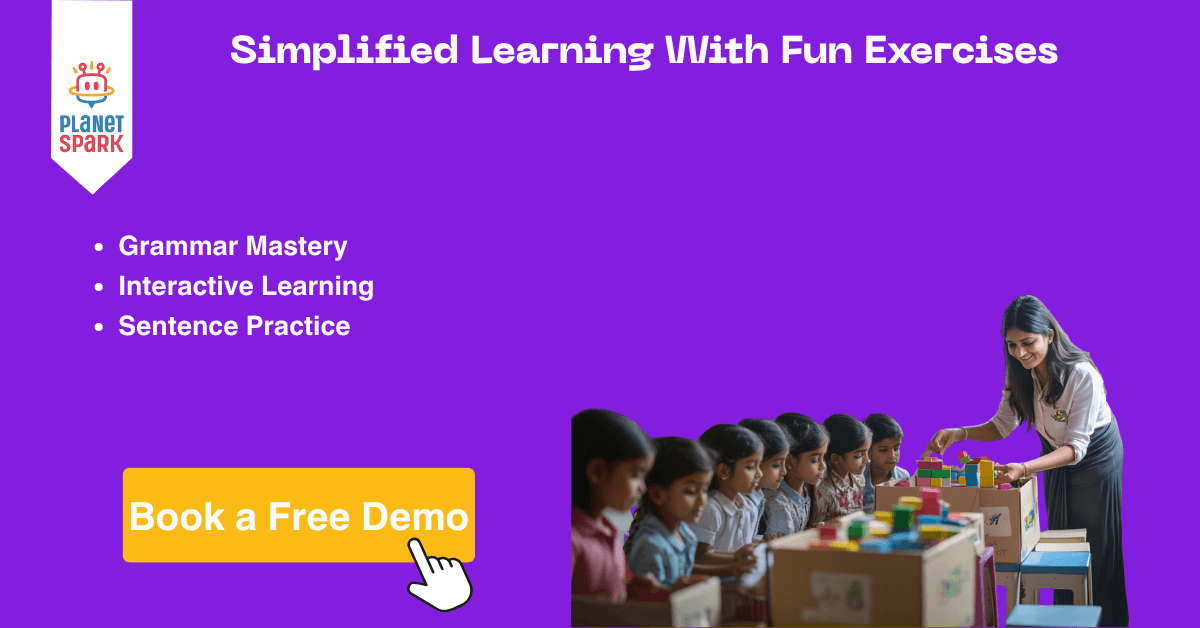English Grammar Prepositions for Class 2 | Learn with Fun Examples

Table of Contents
- What Are Prepositions?
- Why Teach Prepositions to Class 2 Students?
- Types of Prepositions (Aligned with Class 2 Curriculum)
- Practice Exercises: Test Your Knowledge
- Spot the Prepositions: Story Time Activity
- Practice More with Mixed Prepositions
- Enrich Classroom & Home Learning: Tips from Educators
- Linguistic Insights (Simplified)
- PlanetSpark’s Enrichment Tools — Expanding on Core Learning
- Strengthening the Curriculum with Best Practices
- ELF (Extra Learning Features) for Prepositions Mastery
- Quick Summary Table
- About PlanetSpark's English Grammar Courses for Class 2 Kids
- Conclusion
- Conclusion
- Frequently Asked Questions (FAQs)
Understanding prepositions is a key milestone in every child’s English grammar journey. For Class 2 students, mastering prepositions not only improves sentence structure but also sharpens their understanding of spatial relationships, direction, and time in language. In this comprehensive, SEO-friendly guide, we’ll explore prepositions for Class 2 in detail with examples, types, practice worksheets, and more.
PlanetSpark offers a specialized English Grammar Course designed specifically for Class 2 students. Through interactive lessons, fun grammar games, and real-life sentence-building activities, children learn essential grammar topics like nouns, verbs, prepositions, and conjunctions with ease. The curriculum is aligned with early learning needs and focuses on building a strong foundation in sentence construction and grammar usage. With expert teachers and engaging class formats, PlanetSpark ensures every child not only understands grammar but also enjoys learning it.
What Are Prepositions?
A preposition connects a noun, pronoun, or phrase to other words in a sentence, displaying relationships such as time, place, direction, or manner. For Class 2 learners, examples include in, on, under, between, towards, etc.—the foundational connectors that make sentences meaningful.
Example sentences:
I am playing in the park.
The books are on the table.
She walked towards the gate.
Examples:
- I am playing in the park.
- My books are on the table.
- I am going to school.
In these sentences:
- In connects the action with the location (the park).
- On tells where the books are.
- To tells the direction of movement.
Why Teach Prepositions to Class 2 Students?
Based on insights from PlanetSpark resources, printable worksheets, and educational platforms:
Spatial Awareness: Helps children describe object placement using visuals like “The ball is under the table” or “The bird is behind the cage”.
Clarity in Directions: Builds ability to follow and provide directions (“walk across”, “go to the park”).
Sentence-Building Confidence: Reinforces writing and speaking (“The cat is on the mat”, “He slept under the tree”).
Reading & Comprehension: Improves understanding of passages and stories using positional words effectively.

Types of Prepositions (Aligned with Class 2 Curriculum)
1. Prepositions of Place
Indicate location, like in, on, under, behind, between, near, inside, over, etc.
Examples:
The book is in the box.
The vase is on the table.
The puppy is under the bed.
The girl sat beside her friend.
The ball is between the boxes.
2. Prepositions of Time
Refer to when an action happens: in, on, at, before, after, during.
Examples:
School starts at 8 a.m.
My birthday is on Tuesday.
We wait in the evening.
Finish your work before dinner.
3. Prepositions of Direction & Movement
Express movement from one place to another: to, into, towards, through, across, along, alongside, across.
Examples:
She ran into the room.
The train moved through the tunnel.
We ran across the road.
They walked along the beach.
Build Strong Grammar Foundations Early – Sign Up for a Free Class at PlanetSpark!
Practice Exercises: Test Your Knowledge
Fill in the Blanks with: on, in, under
- The pencil fell ______ the table.
- The man climbed ______ the coconut tree.
- The letter was kept ______ the drawer.
- She is sitting ______ a tree for shade.
- Ram went ______ a vacation.
- The money was kept ______ the purse.
Answers:
- Under
- On
- In
- Under
- On
- In
Choose the Correct Preposition:
- The coffee mug is kept ___ the table. (On/Under)
- I was standing ___ the queue. (In/On)
- The students came ___ the classroom. (At/To)
- They rushed ___ the playground. (To/At)
- They escaped by jumping ___ the window. (Out of/Beneath)
Answers:
- On
- In
- To
- To
- Out of
Sentence Correction:
Change the incorrect preposition:
He stood on the hill → should be above the hill.
The dog is in the fence → should be behind the fence
Spot the Prepositions: Story Time Activity
Let’s identify the prepositions in the story below:
Hearing the idea of a race with the tortoise, the hare was much amused. He agreed to the idea just to have some fun. The fox, who had decided to judge the race, began marking the start and endpoint and fixed the distance.
The fox flagged off the race. Both the hare and the tortoise started the race. Soon, the hare was out of sight, much ahead of the tortoise. The tortoise slowly but steadily kept moving towards the finishing line.
After reaching closer to the finish line, just to have some fun, the hare decided to take a nap under a tree. The tortoise passed the tree under which the hare was sleeping and kept moving. Meanwhile, the hare remained unaware of this and kept sleeping peacefully. When he woke up, the tortoise was almost at the finish line. The hare ran the fastest but still could not catch up. Finally, the tortoise won the race.
Worried About Grammar? Let Your Child Learn with Experts – Free Trial Session Available!
Practice More with Mixed Prepositions
Use correct prepositions from the box: at, in, with, of, for, to
- My mother was angry ______ me because I tried to lie.
- My sister is perfect ______ singing.
- Akram has no interest ______ video games.
- My sister was happy ______ me as I helped her.
- Vipul is good ______ history.
- The baby smiled ______ me.
- The little girl stopped and asked ______ an address.
- One should always be kind ______ others.
- My brother is afraid ______ ghosts.
- My sister took me ______ the market.
Answers:
- At
- At
- In
- With
- In
- At
- For
- To
- Of
- To
Start Your Child’s Grammar Journey with a Free Trial Class at PlanetSpark!
Enrich Classroom & Home Learning: Tips from Educators
Use visuals and real objects: Kids learn better when they can see the location (e.g. place a toy under a book, then ask: “Where is the toy?”).
Story-based illustration: Use short simple narratives that highlight prepositions (e.g., “The frog jumped into the pond, then under the lily pad.”).
Audio chants or songs: Periwinkle and British Council videos demonstrate prepositions with catchy tunes and repetition.
Progressive difficulty: Begin with basic prepositions (in, on, under), then introduce compound and less common ones like beneath, alongside, within, among.
Linguistic Insights (Simplified)
Traditional grammar identifies prepositions as words that take a noun phrase complement (forming a prepositional phrase), e.g., “on the table”, “in the house”.
While Class 2 focuses on basic spatial and temporal use, advanced learners can explore how prepositions sometimes combine with clauses or adverb phrases ("despite of", "throughout").
PlanetSpark’s Enrichment Tools — Expanding on Core Learning
PlanetSpark’s engagement goes beyond worksheets by offering:
Interactive video worksheets aligned to prepositions-based lessons, often developed by educational experts with visuals and prompts for Class 2 learners.
Simplified, structured breakdowns of prepositions by age group so kids in Class 2 only learn age-appropriate vocabulary like “in, on, under, behind, between” before advancing to more complex ones.

Strengthening the Curriculum with Best Practices
Introduce 5–7 core prepositions per lesson: Begin with in, on, under, then gradually add between, beside, above.
Reinforce with visuals: Show real or drawn objects for visual learners.
Story use & repetition: Children internalize prepositions through repeated short-story exposure.
Assess & repeat: Use exercises like fill-in, multiple choice, and sentence corrections weekly.
Progress tracking: PlanetSpark’s progress reports and PTMs (parent‑teacher meetings) help parents track how well their child is using prepositions in speaking and writing.
ELF (Extra Learning Features) for Prepositions Mastery
Daily micro quizzes (“SparkBee”) with one or two targeted sentences using prepositions.
Visual storytelling clubs where kids narrate scenarios (e.g. “My pencil is under the bag”) to peers.
AI-led practice with prompts like “Put the teddy on the table”, “Move the car into the box”.
Quick Summary Table
| Focus Area | Examples for Class 2 | Why It Matters |
|---|---|---|
| Place | in, on, under, behind, between | Describes where objects are placed |
| Time | at (specific), on (days), in (months/periods) | Clarifies when actions take place |
| Direction & Movement | to, into, towards, across, through | Expresses movement or goal orientation |
About PlanetSpark's English Grammar Courses for Class 2 Kids
PlanetSpark offers world-class, interactive, and engaging grammar learning experiences for young learners. Our English Grammar Courses for Class 2 children are designed to:
- Build strong grammar fundamentals, including prepositions, nouns, adjectives, tenses, and more.
- Make learning fun through games, quizzes, storytelling, and digital worksheets.
- Improve sentence formation, spoken English, and writing skills.
Conclusion
Prepositions are essential building blocks of grammar for Class 2 students, enabling them to describe where, when, and how actions happen.
Worksheets from PlanetSpark and reputable education websites offer fun, visual, and practice-rich resources that reinforce learning (e.g. matching pictures and prepositions, fill‑ins, sentence corrections).
When combined with storytelling, gamified quizzes, and consistent reinforcement, prepositions become intuitive tools in your child's expressive skills toolkit.
Features of PlanetSpark's English Programs:
1:1 Personal Trainers for Every Child
Certified English trainers provide 100% attention with:
- Personalized pace and feedback
- Focused grammar correction
- Confidence-building mentorship
Personalised Learning Roadmap
Each child gets a custom learning plan based on skill assessment. The roadmap evolves with the child’s growth.
SparkX – AI Video Feedback Tool
Children record speeches or stories that are analysed for grammar, clarity, fluency, and delivery.
AI-Led Speaking Practice
Real-time AI coach provides instant grammar and fluency corrections during storytelling and dialogue simulations.
Spark Diary
Promotes daily creative writing practice via digital journaling.
Gamified Grammar Practice
Kids engage with grammar through:
- Antonyms quiz
- Grammar Guru Challenge
- Listen and Spell
- Daily quizzes
Detailed Progress Reports
Includes grammar accuracy, fluency, and trainer feedback to track grammar development.
Parent-Teacher Meetings
Frequent PTMs keep you updated with your child’s grammar progress and learning goals.
SparkShop & SparkBee
- SparkBee: Daily grammar quizzes & challenges
- SparkShop: Interactive eBooks for grammar & writing
Conclusion
Prepositions are crucial for building meaningful sentences. They help children identify and express the relationship between words in terms of time, place, and direction. With the support of engaging practice, fun storytelling, and smart technology from PlanetSpark, your child can gain strong foundational grammar skills early on.
Let your child master English grammar confidently with PlanetSpark.
Book a Free Demo Class Now and Watch Your Child Excel!
Frequently Asked Questions (FAQs)
Q1. What are prepositions?
A: Prepositions are words that show the relationship between a noun/pronoun and other words in a sentence. Example: The book is on the table.
Q2. Why are prepositions important in grammar?
A: They help children understand how different words relate, especially in terms of time, place, and movement.
Q3. How can PlanetSpark help with prepositions for Class 2?
A: PlanetSpark’s personalised grammar courses use games, storytelling, and AI tools to teach prepositions effectively.
Q4. What types of prepositions should Class 2 kids know?
A: Prepositions of time (at, on), place (in, under), and direction (to, through, into) are ideal for this level.
Q5. Are there online exercises for practicing prepositions?
A: Yes, PlanetSpark provides interactive grammar worksheets and digital quizzes tailored to Class 2 kids.
Q6. How many prepositions should a Class 2 student learn?
A: Start with 10-15 basic prepositions like in, on, under, between, at, to, for, of, with, and into.
Q7. Can prepositions be taught through stories?
A: Absolutely! Using short stories and narratives makes learning prepositions engaging and memorable for children.
Personalized Communication Report
Record a video to get a AI generated personalized communication report for your child

Hi There, want to try these
tips for your child with
LIVE with our expert coach?
Let's check your child's
English fluency
